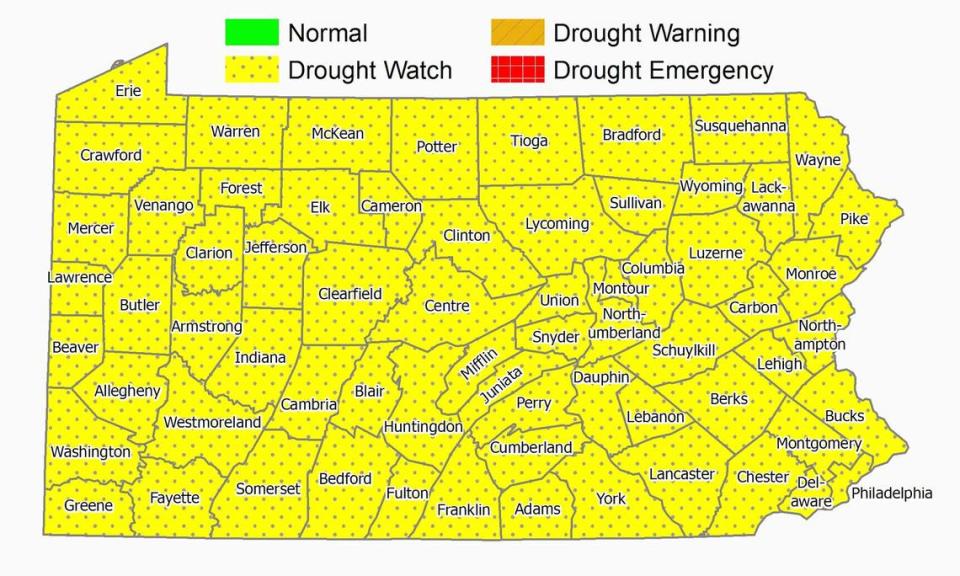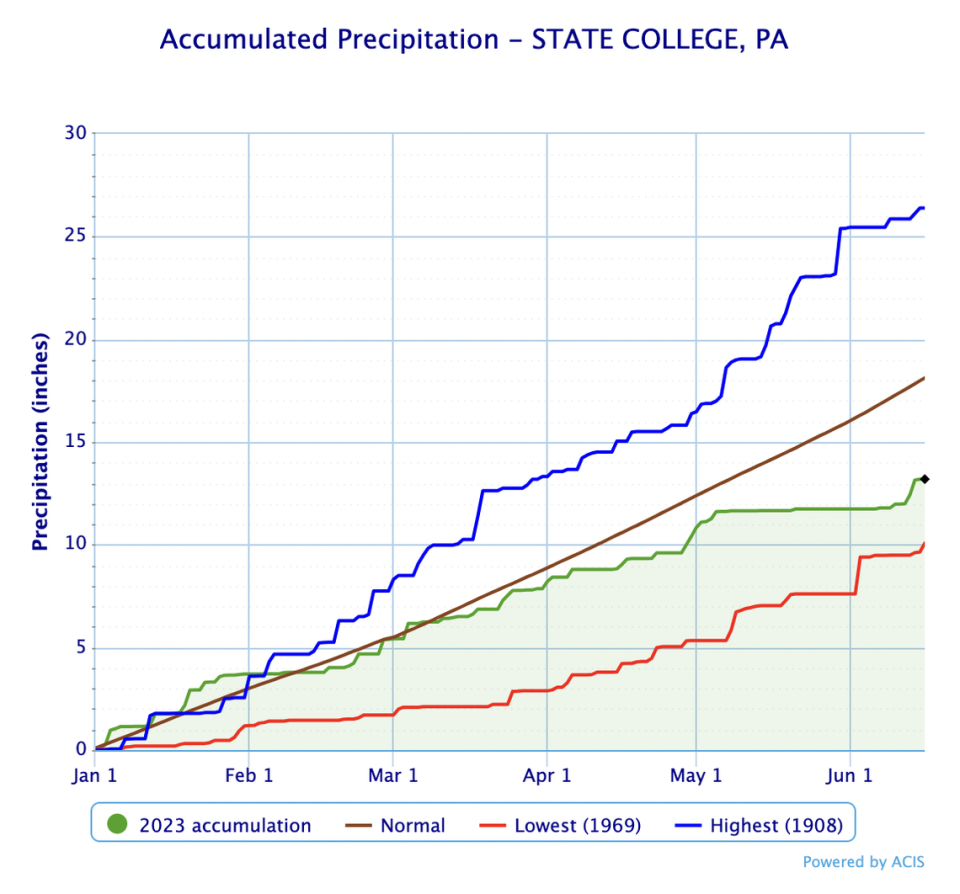All of Pennsylvania is under a drought watch. Here’s how you can save water at home
Though much-needed rain has fallen in recent days, Pennsylvania officials have placed the entire commonwealth under a drought watch as patterns of below-average precipitation continue through mid-June.
The Pennsylvania Department of Environmental Protection issued the watch Thursday after hearing recommendations from the Commonwealth Drought Task Force. Under the watch, residents and businesses are encouraged — but not required — to conserve water by cutting down on nonessential use.
“Although this week has brought some welcome rain to much of the state, it’s not enough to make up for the lack of rainfall this spring, following a winter that brought little snowfall in many areas,” Rich Negrin, acting DEP secretary, wrote in a statement. “As a result, we’re seeing lowered stream flows, dropping groundwater levels, and persistent precipitation deficits. Water conservation, always a good practice, is especially helpful now as it’ll lessen potential future impacts on water supplies if rainfall continues to be scant this summer.”
While a drought watch persists across the entire commonwealth, no Pennsylvania counties are experiencing a drought warning or drought emergency as of June 15.

According to the DEP, at least 18 Pennsylvania public water suppliers have asked for voluntary water conservation in their communities. You can track drought statuses and information about your local water supplier by visiting dep.pa.gov/Business/Water/PlanningConservation/Drought/pages/default.aspx.
Drought-like conditions across Pennsylvania heighten risks for wildfires, the Pennsylvania Department of Conservation and Natural Resources warned in a statement.
Pennsylvania has reported at least 1,400 wildfires so far in 2023, easily exceeding 2022’s 1,036 reported fires. This year’s blazes have burned at least 8,500 acres, again outpacing 2022’s 2,700 burned acres.
“We’ve had an unprecedented year for wildfires in the Commonwealth, and we encourage all Pennsylvanians to act responsibly to prevent wildfires as dry conditions persist,” DCNR Secretary Cindy Adams Dunn said in a statement. “Pennsylvania wildfires pose a threat to public health because of the smoke they create. Though significantly smaller than the 10-million-acre wildfires in Canada, Pennsylvania wildfires still create the same hazardous air conditions in the areas impacted.”
What is a drought watch?
Droughts are typically measured through the Palmer index, which analyzes soil moisture, temperature and precipitation to determine drought severity, the U.S. Geological Survey reports. Pennsylvania issues a drought watch when a county’s Palmer index falls between -2 and -2.99, upgrading to a drought emergency as levels reach between -3 and -3.99.
While drought watches are not irreversible or overly concerning, they can cause damage to crops, prompt water shortages and lower levels for wells and streams, the U.S. Drought Monitor says. Warnings generally prompt mandatory water restrictions and shortages.
You can view the U.S. Drought Monitor map, updated weekly, online at drought.gov/data-maps-tools/us-drought-monitor.
Tips for conserving water
According to the U.S. Environmental Protection Agency, the average American family uses around 300 gallons of water per day. Roughly 70% of that comes from indoor sources, including showers, sink faucets and toilets.
Cutting out water use entirely is not necessary or even feasible, but there are several steps you can take to limit your consumption, according to the DEP:
Turn off your faucets while washing your dishes, brushing your teeth or shaving.
When necessary, water plants in the mornings or evenings. Focus on new plants that have shallower root systems.
Run dishwashers and washing machines less often, perhaps using low-water cycles. Prioritize full loads.
Water lawns only when necessary.
Check for leaks in your toilets, faucets and pipes.
When mowing your lawn, set the blades 2 or 3 inches high. Taller grass can shade soil and improve moisture retention.
Sweep your decks, sidewalks and driveways instead of using a hose.
Set up a rain barrel to repurpose rain when it falls.
Precipitation in Centre County
Though scattered thunderstorms are in Friday’s forecast, major drought relief is not expected in the immediate future, local experts say.
According to AccuWeather senior meteorologist Tom Kines, the Centre Region is in for several days of warmth and sunshine heading into next week. Drier weather could upend some benefits recent rain brought to the area.
“The rain that we’ve had this week has certainly helped us,” Kines said Friday morning. “Unfortunately, there’s concern that the bulk of next week will be dry... There should be a great amount of sunshine, and that’s great for outdoor activities. But if you’ve got a garden or a lawn or crops, that’s not good news. At this time of year, if you’ve got the sun out for a few days, any rain that you’ve received dries up real quick. Evaporation rates at this time in the year are quite high.”
“While we did get some beneficial rain over the past few days, there’s fear that we’re getting back into a dry pattern,” Kines added.
According to the National Weather Service, the State College area has observed approximately 13.19 inches of precipitation this year — well short of 18.12 inches, the amount the area typically sees in a “normal” season through mid-June. Nearly an inch and a half of rain fell within the last week thanks to some much-needed showers and thunderstorms, but the Centre Region remains well below historical averages so far this year.

“It’s always tough to predict, but we do feel that, in time, we will start to catch up — or at least not get any worse,” Kines said regarding below-average precipitation in central Pennsylvania this year. “When that happens is hard to say. Maybe in July, we’ll start getting more frequent opportunities for rain. By the end of the year, when it’s all said and done, I think we’ll have caught up or not gotten much worse.”
State College saw its driest year through mid-June in 1969 when just 10.07 inches of precipitation fell through June 16, according to NWS records. The wettest, on the other hand, came in 1908 after analysts recorded 26.39 inches of precipitation through mid-June.

